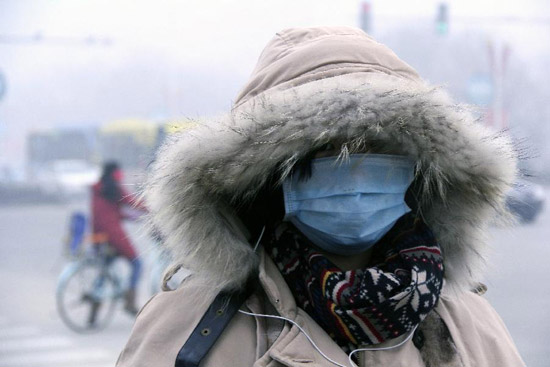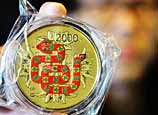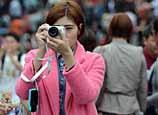
 |
| A citizen wearing face mask walk in fog in Liaocheng City, east China's Shandong Province, Feb. 17, 2013. (Xinhua/Zhang Xianju) |
According to a recent research by the Chinese Academy of Science (CAS), the thick haze in January is the joint result of atmospheric stability in central and east China, pollutant disposal, floating dust, and abundant water vapor. It is associated with both natural and human factors.
Chen Liangfu, member of the special project team and researcher of Institute of Remote Sensing and Digital Earth, CAS, said mixed particles will form when soluble components of the air pollutants meet nucleuses of dust minerals. The particles’ diameters will increase by two or three times in humid air, and their visibility will decease to one eighth to one ninth of the original level.
In Photo: Smog shrouds Beijing and some other cities in China
In common term, the particle pollutants in the air will become larger visible particles after meeting the vapor. Then dust haze occurs.
According to Wang Yuesi, researcher of CAS' Institute of Atmospheric Physics, the thick haze pollutants that struck middle and east China are comprised of the contaminants that led to great London smog of 1952 and Los Angeles photochemical smog in the 1940s, as well as dust aerosol.
The special research on haze in Beijing, Tianjin and Hebei detected many nitrogenous organic particles. This, in the eyes of Wang, is "the most worrisome sign", because "this is the major component of the Los Angeles photochemical smog".
Nitrogenous organic particles are the products of reaction among large amounts of sulfur dioxide, nitrogen oxides and volatile organic compounds. Vehicle exhaust was the main source of the Los Angeles photochemical smog. There were 2.5 million vehicles in Los Angeles in the 1940s, emitting more than 300 tons of oxynitride daily.
"Controlling dust haze should start with controlling the emission of pollutants,” said Wang.
Motor vehicles are the principal contributor to the PM 2.5 in Beijing, accounting for 25 percent or so, followed by coal-firing and pollutants from elsewhere, which number 20 percent each.
The regions of Beijing, Tianjin and Hebei, in the opinion of special project team, should give priority to the control of industry and coal-firing, as well as desulfurization, denitration and dedusting of the combustion process. Attention should also be paid to diesel vehicle emissions and oil quality.
Read the Chinese version: 中科院专项研究还原京津冀雾霾天气产生过程; Source: China Youth Daily
















 Slacklife in Beijing: China's 'No 1 Slackliner'
Slacklife in Beijing: China's 'No 1 Slackliner'


![]()
